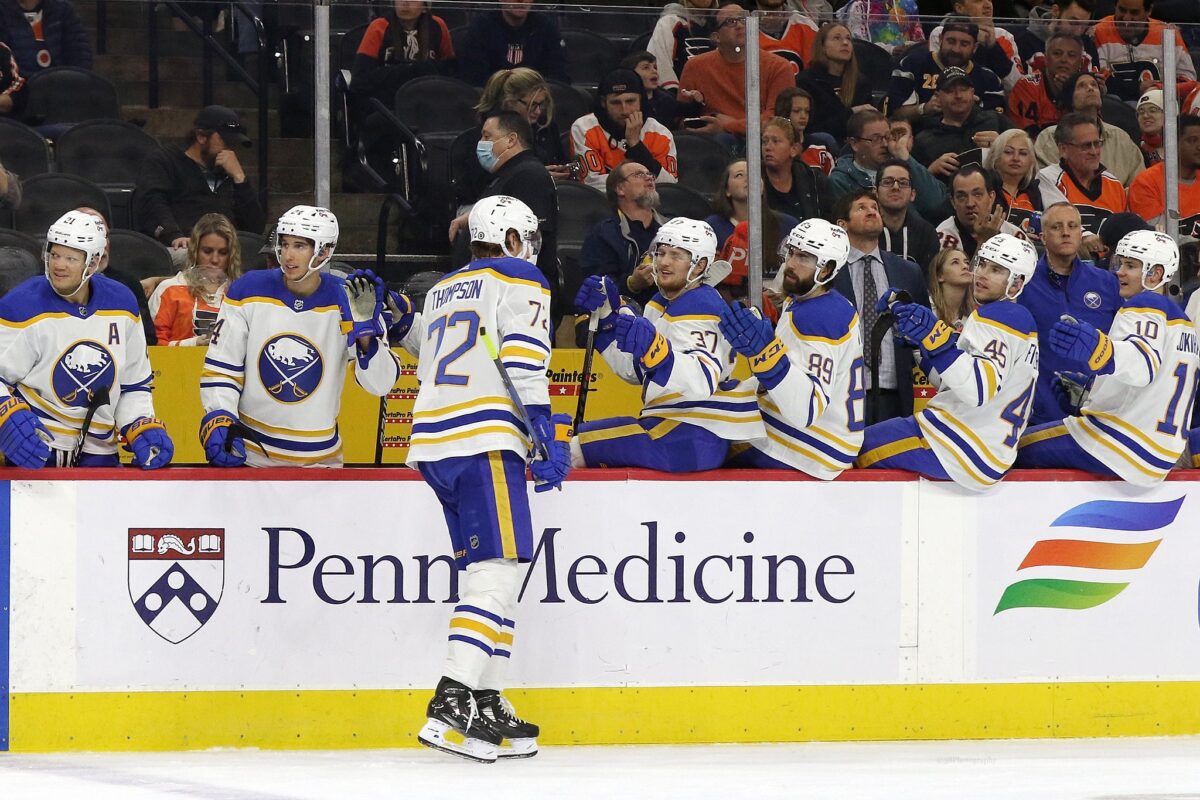Heading into the All-Star Break the Buffalo Sabres had a rough stretch of games. Despite an incredible Central Division road trip that saw them bring home seven out of a possible eight points, the Sabres lost two in a row. First to the Minnesota Wild in a shootout, and then to the Carolina Hurricanes at home. After the All-Star Break, hopes were high that a little bit of rest would do them some good, and they would be able to come out swinging.
Unfortunately, the Sabres did not. Instead, they lost 7-2 to the Calgary Flames at home on Feb. 11, and then set out to California to play the Los Angeles Kings on Feb. 13. Heading into the game, coach Don Granato decided to switch up the lines quite considerably.
Drastic Line Changes Not Effective
Of the line changes made, the first line was the most notable difference. Usually home to Alex Tuch, Tage Thompson and Jeff Skinner, Thompson ended up moving to the second line while Dylan Cozens assumed the first-line center role. Thompson’s new linemates became captain Kyle Okposo and Casey Mittlestadt, who usually occupy the third and fourth lines. The bottom six was rounded out by Tyson Jost, Rasmus Asplund and Victor Olofsson on the third line, and Peyton Krebs, Zemgus Girgensons and Jack Quinn on the fourth.
Though a small sample size, it became clear that jumbling the lines was not going to work right away. They played an absolutely abysmal game against the Kings, giving up four goals in the second period and sending Sabres fans back on the east coast to bed early, before losing the game 5-2.
However, small changes have proven to be effective. In their game against the Anaheim Ducks on Feb. 15, Granato kept the top line of Skinner, Thompson and Tuch together while only doing some shuffling in the bottom six.

Krebs saw himself moved to the third line, centering Quinn and Mittelstadt, while Jost took the role of fourth-line center on a line with Girgensons and Okposo. The game was rocky, with the Sabres having another uninspired second period that saw the Ducks go up 3-2. Luckily, they fought back in the third period and ended up winning 7-2.
Managing Team Chemistry
One of the biggest advantages the Sabres have right now is team chemistry. In previous seasons throughout the playoff drought, they have lacked the ability to play well together both on and off the ice. Any shake-up to that team chemistry, like assigning everyone new linemates, usually requires a learning curve before they’re able to figure it out.
We saw that with the addition of Jost earlier this season, and with the lines being jumbled in the midst of another small losing streak. At this point in the season, you have to ask if it’s worth it to make any wholesale changes to the lineup on a night-to-night basis.
Related: Sabres’ Lack of Adjustment is Ruining Their Playoff Hopes
While chasing a wildcard spot for the first time in nearly a decade, it’s worth remembering that making the playoffs wasn’t necessarily the end goal at the beginning of the season. The goal was to improve development with the plethora of young players in Buffalo this year and aim for the playoffs next season. The fact that they’re so close this season has been a surprise. A welcome one, but still a surprise.
With the trade deadline coming up, general manager (GM) Kevyn Adams is going to have to make a difficult decision. Does he make a deal that perhaps gets the Sabres to the playoffs this year, or does he wait it out?
Many names have been thrown around as potential trade bait, with Mittlestadt being one of the more common ones. He’s had a good few games recently, putting up 16 points in his last 21 games, but has been an incredibly streaky player throughout his tenure with the Sabres. Adams could get a better return for him while his value is higher, but he would still be risking the lineup changes that come with it.

Historically, Adams tends to be a more conservative GM. He preaches patience and cultivating the talent currently with the organization. There need to be moves made if they want to make any sort of push for the playoffs in the future, whether it’s this season or next. It’s up to the players and Granato to figure out a way to take these changes and make them work within the group that they already have.